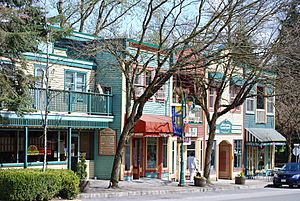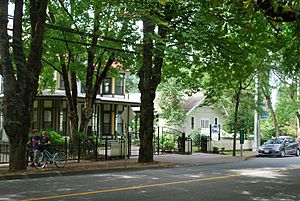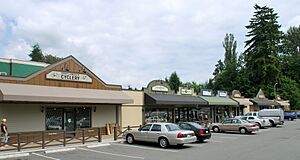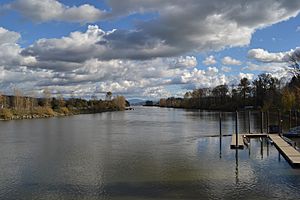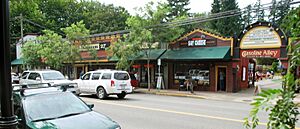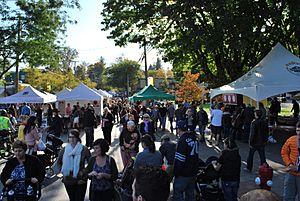Fort Langley facts for kids
Quick facts for kids
Fort Langley
|
|
|---|---|
|
Community
|
|
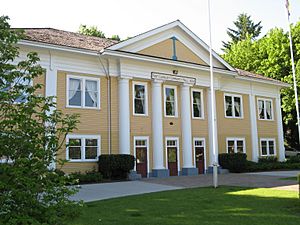
Fort Langley Community Hall
|
|
| Country | Canada |
| Province | British Columbia |
| Region | Lower Mainland |
| Regional district | Metro Vancouver |
| District Municipality | Langley, British Columbia (district municipality) |
| Established | 1827 |
| Area | |
| • Total | 2 km2 (0.8 sq mi) |
| • Land | 2 km2 (0.8 sq mi) |
| Population
(2021)
|
|
| • Total | 3,836 |
| • Density | 1,751/km2 (4,540/sq mi) |
| Time zone | UTC-8 (Pacific (PST)) |
| • Summer (DST) | UTC-7 (PDT) |
| Area code(s) | 604, 778, 236 |
Fort Langley is a small village community in the Township of Langley, British Columbia, Canada. About 3,400 people live here. It is famous for being the home of Fort Langley National Historic Site. This historic site was once a fur trade post for the Hudson's Bay Company. Fort Langley is located on the Fraser River, at the northern edge of the Township of Langley.
Contents
History of Fort Langley
Fort Langley got its name from Thomas Langley, who was a director at the HBC. The fort was built at a time when the border between British and American lands in the west was not yet decided. This area was known as the Columbia District to the British.
Sir George Simpson, who was the Governor of the Hudson's Bay Company, worried that Fort Vancouver (near what is now Portland, Oregon) might become American territory. He thought the border might be set at the 49th parallel north. So, in 1827, Simpson ordered the Hudson's Bay Company to build the first Fort Langley. It was built about 4 kilometers downstream from where it is today.
Fort Langley was built on the south side of the Fraser River on purpose. This was to make sure Britain had a claim to both sides of the Fraser River, even if Fort Vancouver was lost to the Americans. By 1830, Fort Langley was a big port for exporting salted salmon, cedar lumber, and shingles to the Hawaiian Islands.
The Border and New Capitals
As Sir George Simpson had feared, the border was set at the 49th parallel north in 1846. This was part of the Oregon Boundary Dispute. Before the Colony of Vancouver Island and the Colony of British Columbia joined together, Governor Sir James Douglas chose Fort Langley to be the temporary capital of the colony.
By 1858, a town called Derby was planned next to the original fort. Land was sold, and construction began on buildings for the Royal Engineers. However, Colonel Richard Moody, who led the Royal Engineers, did not like Douglas's choice for the capital. He pointed out that American territory was only a few miles away, and Fort Langley would be hard to defend.
So, in 1859, Moody picked a new spot at the mouth of the Pitt River. He suggested naming the new town Queensborough. Later that year, Governor Douglas announced that the new capital would be called New Westminster.
Growth and Changes
Before the Fraser Canyon Gold Rush, Fort Langley was important for exporting cedar lumber, cedar shakes, and salted salmon. These goods were packed in barrels and shipped to the Hawaiian Islands. Once the military work of Fort Langley moved to New Westminster, the town of Derby started to decline.
To handle more ships, a new location was chosen along the Bedford Channel. This spot was protected from the river's strong currents by McMillan Island and Brae Island. This new location is where the town of Fort Langley is now, where Glover Road meets the Fraser River.
Between the 1850s and the 1920s, Fort Langley saw many changes. These included the threat of invasion, the gold rush, and Canadian Confederation in 1867. The first train arrived in the early 1900s.
In 1921, a large saw mill opened on an 88-acre property by the river. This mill brought many jobs and helped the town grow. The town became a working-class community. By the end of the 1980s, the mill started to close down. It finally shut down for good in the mid-1990s.
In 1921, Dr. Benjamin Marr planted Horse Chestnut trees along Glover Road. You can still see these trees when you enter the downtown area today.
As more people became educated and moved from blue-collar to white-collar jobs, the demand for new homes in Fort Langley grew. In 2005, the old lumber mill site was approved for new housing. In 2006, construction began on a large community called Bedford Landing. This new development will add about 1,500 new people to the community.
Indigenous People
The Kwantlen First Nation manages an Indian Reserve on McMillan Island. This island is across the Bedford Channel from Fort Langley. The local First Nations people were important trade partners for the Hudson's Bay Company at Fort Langley. Many workers at the Fort married women from the local First Nations.
Fort Langley Today
In recent years, many old buildings in Fort Langley have been fixed up. These restored buildings, along with the beautiful natural setting, river access, mountain views, and the historic Fort itself, make Fort Langley a popular place for tourists.
You can enjoy outdoor activities like canoeing, fishing, hiking, and horseback riding. The town is also a popular spot for filming commercials, TV shows, and movies. The yellow community hall is often seen in these productions.
Many new buildings have been built in Fort Langley recently. All new buildings must follow strict rules to look like the older, historic buildings. An example of this style is the Fort Mall. There are also very few big chain stores in the village. This makes Fort Langley a special place for tourists and independent shops, attracting hundreds of thousands of visitors each year.
The Coulter Berry building is a special landmark built in 2016. It is a Leadership in Energy and Environmental Design (LEED) Gold building, meaning it was built to be very good for the environment. This three-story building has shops, offices, and restaurants. It mixes modern ideas with a historic look. In 2016, it won an award for being the best mixed-use building in the Fraser Valley.
Downtown Fort Langley is right on the Fraser River. A public walkway along the riverbank was built as part of the Trans-Canada Trail. A rowing facility was also completed in 2009.
TinyKittens Society, a group that helps cats, is based in Fort Langley.
Culture in Fort Langley
Community Hall and Library
The historic Fort Langley Community Hall has meeting spaces and a branch of the Fraser Valley Regional Library. The Fort Langley Community Improvement Society was started in 1924 to build this hall. It was finished in 1931 by workers and volunteers. The architect was Archibald Campbell Hope.
The Fort Langley Community Hall has been in many films and TV shows, like the Air Bud movies and the TV series Once Upon a Time. Today, the hall hosts community meetings, craft markets, and weddings. It is still owned by the Fort Langley Community Improvement Society and run by volunteers.
Parks
Fort Langley has several parks for everyone to enjoy. These include Fort Langley Community Park, Hudson's Bay Park, Brae Island Regional Park, and Marina Park. Marina Park has a boat launch for accessing Bedford Channel. Brae Island Regional Park is home to Fort Camping, which has campsites for groups and RVs.
Merchants and Shopping
Glover Road is a popular shopping street in the center of Fort Langley. People from Langley and tourists love to visit for its unique independent businesses and historic feel.
Fort Langley has about eighty businesses, including services, restaurants, and retail stores. In 2011, the IGA grocery store, which had been there since the 1970s, burned down. In 2012, the same owners opened a new store called Lee's Market. They made sure the new store kept the traditional historic look of Fort Langley.
Fort Langley is a central place for services and amenities for nearby communities like Forest Knolls, Glen Valley, and the Kwantlen First Nations. It is also a favorite spot for people from Walnut Grove.
Museums
- The Fort Langley National Historic Site is a former fur trading post that attracts about 60,000 visitors each year.
- The BC Farm and Equipment Museum has a collection of old farming tools and machines.
- The Langley Centennial Museum shows local historical items and offers cultural programs.
Events
The Cranberry Festival started in 1995 and takes place every October. It is organized by the Fort Langley Business Improvement Association.
Every year on July 1st, the Centennial Museum, the BC Farm Museum, and Fort Langley National Historic Site work together to organize the Township of Langley's Canada Day celebrations.
A May Day celebration is held every year on Victoria Day in Fort Langley. It includes a parade and a party in a local park with Maypole dancing.
The first annual Fort Langley Jazz Festival was held in July 2018.
Transportation
Roads
The main road into and out of Fort Langley is Glover Road. It connects to British Columbia Highway 1 and British Columbia Highway 10. Other roads like 88 Avenue, 96 Avenue, and River Road link Fort Langley to Walnut Grove and the rest of Langley Township.
Most roads in Fort Langley have historical names instead of the numerical system used in other parts of the South Fraser Region.
The Jacob Haldi Bridge connects Fort Langley to McMillan Island across the Bedford Channel.
Airport
The private Fort Langley Airport has a paved runway and facilities for floatplanes. It is located east of the community. Most general aviation users fly from the Langley Regional Airport, which is about 8 kilometers south of Fort Langley.
Albion Ferry (closed)
Until 2009, people traveling to and from the Albion Ferry, which connected to Maple Ridge, passed through Fort Langley. However, after the Golden Ears Bridge opened, the ferry stopped running on July 31, 2009. The ferry terminal is now empty. This has greatly reduced the amount of traffic in downtown Fort Langley.
Bus Service
Fort Langley is served by TransLink's 562 bus route. This bus can take you to either Langley Centre or Walnut Grove (Carvolth Exchange).
Infrastructure
Fire Hall
The community is served by the Township of Langley Fire Department Hall 2. This fire hall is staffed by firefighters who are paid when they are called for duty.
Education
Fort Langley is part of School District 35 Langley. It has two schools: Fort Langley Elementary School and Langley Fine Arts School. Langley Fine Arts School is a special school for arts from Kindergarten to Grade 12. Trinity Western University is located just south of Fort Langley.




